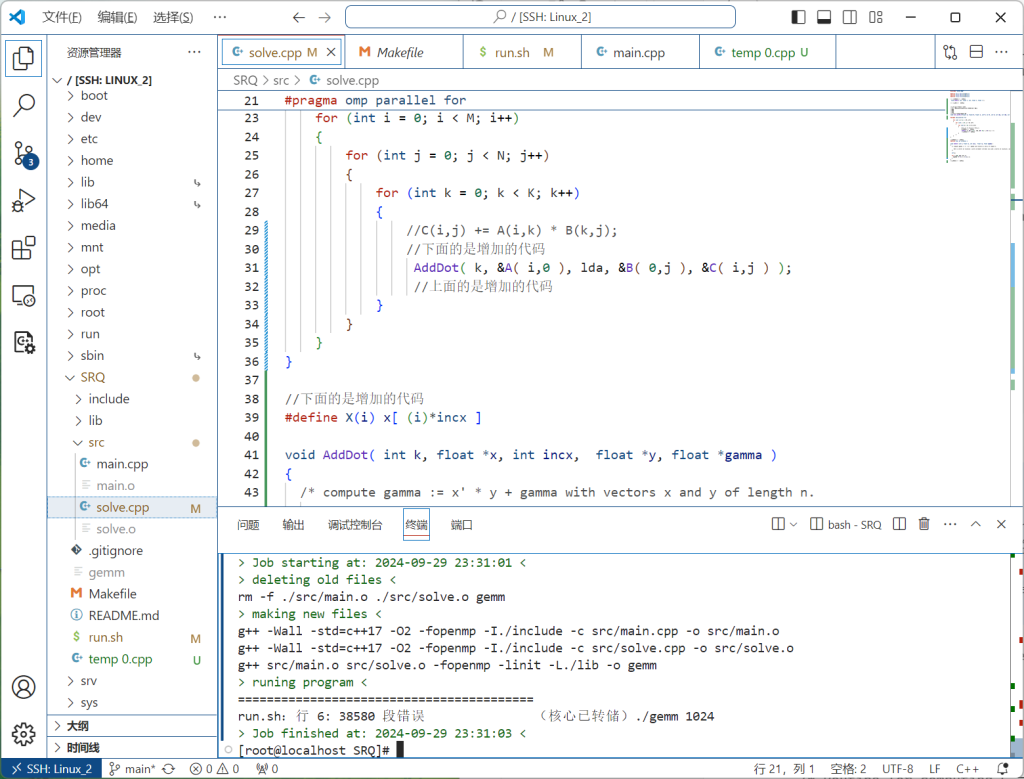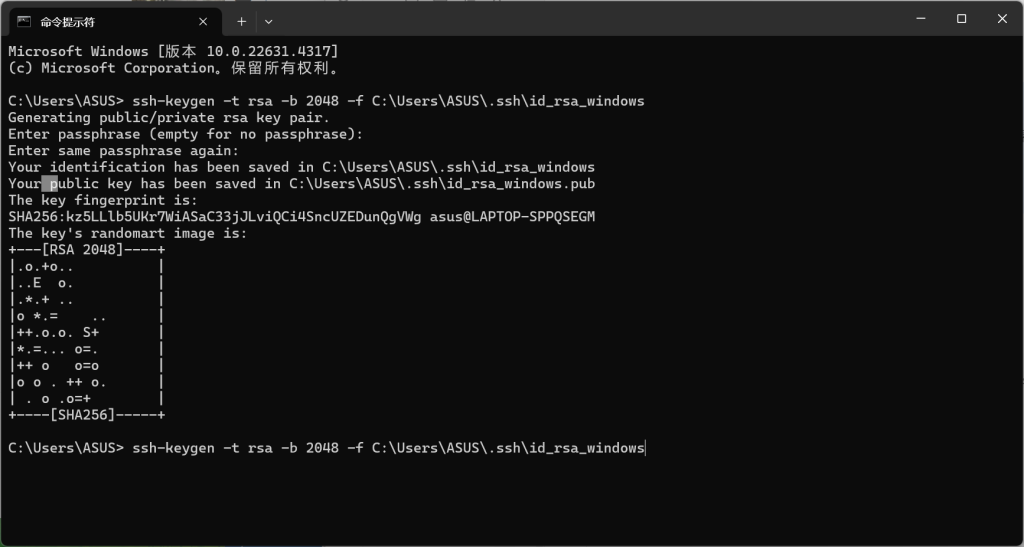模板内核函数的参数
使用模板内核函数能够显式声明和调整变量,非常适用于一些需要(在 kernel 函数外面)动态划分,但是在 kernel 函数中却又为常量的变量。
- 可以在 kernel 外面进行动态调整【增加程序适用性】
- 会进行预编译替换常量值【类似
#define】减少运行时间
这两个条件,简直为线程块相关数值变量量身定制!
运用设想
在 kernel 函数中提取线程块相关数值变量
对 kernel 函数进行包装
在包装函数内对相关变量进行动态划分
运用示例
下面这个实例是本人在对卷积算子进行 im2col 优化操作时看到的一个 SEMM 算子
kernel 函数:
template <const int BM, const int BN, const int BK, const int TM, const int TN>
// __launch_bounds__((BM * BN) / (TM * TN), 1)
__global__ void
sgemm_blocktiling_2d_kernel(half *A,
half *B,
half *C,
int M,
int N,
int K,
int batch,
int kernel_num,
int y_height,
int y_width)
{
// BM, BN, BK:block tile 的尺寸,分别代表 block 处理的 M 方向、N 方向和 K 方向的大小。
// TM, TN:单个线程计算的子块大小,每个线程计算 TM × TN 个元素。
// A、B、C:输入矩阵 A、B 和输出矩阵 C(存储在全局内存中)。
// M、N、K:矩阵的维度,使 C = A × B,其中:
// A 维度为 (M × K)
// B 维度为 (K × N)
// C 维度为 (M × N)
// the output block that w e want to compute in this threadblock
const uint c_row = blockIdx.y; // 当前 block 负责的 C 的行块索引
const uint c_col = blockIdx.x; // 当前 block 负责的 C 的列块索引
// 每个 thread block 计算 BM × BN 大小的 C 的子块,c_row 和 c_col 决定了该 block 处理 C 矩阵的哪一部分。
const uint num_threads_block_tile = (BM * BN) / (TM * TN);
// 一个 block 共有 (BM * BN) / (TM * TN) 个线程,即 block 计算的区域被 TM × TN 大小的线程组分割。
__shared__ half A_shared[BM * BK];
__shared__ half B_shared[BK * BN];
// 共享内存用于缓存 A 和 B 的子块,减少全局内存访问,提高计算效率。
// the inner row & col that we're accessing in this thread
const uint thread_row = threadIdx.x / (BN / TN); // 线程在 block tile 内的行索引
const uint thread_col = threadIdx.x % (BN / TN); // 线程在 block tile 内的列索引
// advance pointers to the starting positions
// 调整 A 和 B 指针,使其指向 block 负责的区域,同时计算 C 的起始索引。
A += c_row * BM * K;
B += c_col * BN;
int global_c_index = c_row * BM * N + c_col * BN;
// use to avoid out-of-bounds accesses
// 用于避免越界访问,确保加载 A 和 B 的元素不超过矩阵尺寸。
int global_m_pos = c_row * BM * K;
int global_n_pos = c_col * BN;
const uint m_size = M * K;
const uint n_size = N * K;
assert((BM * BN) / (TM * TN) == blockDim.x);
// 通过线程索引计算 A 和 B 在共享内存中的存储位置,采用 stride_a 和 stride_b 进行跨步加载。
const uint A_inner_row = threadIdx.x / BK; // warp-level GMEM coalescing
const uint A_inner_col = threadIdx.x % BK;
const uint stride_a = num_threads_block_tile / BK;
const uint B_inner_row = threadIdx.x / BN; // warp-level GMEM coalescing
const uint B_inner_col = threadIdx.x % BN;
const uint stride_b = num_threads_block_tile / BN;
// allocate thread-local cache for results in registerfile
// 分配寄存器用于计算
// 每个线程存储 TM × TN 个计算结果,避免频繁访问全局内存。
float thread_results[TM * TN] = {0.0};
half reg_m[TM] = {0.0};
half reg_n[TN] = {0.0};
// outer loop over block tiles
for (uint bk_idx = 0; bk_idx < K; bk_idx += BK)
{
// load the next block of the input matrices into shared memory
for (uint load_offset = 0; load_offset < BM; load_offset += stride_a)
{
A_shared[(A_inner_row + load_offset) * BK + A_inner_col] =
(global_m_pos + (A_inner_row + load_offset) * K + A_inner_col < m_size) ? A[(A_inner_row + load_offset) * K + A_inner_col] : __float2half(0.0f);;
}
for (uint load_offset = 0; load_offset < BK; load_offset += stride_b)
{
B_shared[(B_inner_row + load_offset) * BN + B_inner_col] =
(global_n_pos + (B_inner_row + load_offset) * N + B_inner_col < n_size) ? B[(B_inner_row + load_offset) * N + B_inner_col] : __float2half(0.0f);;
}
// wait for all threads to finish loading
__syncthreads();
// advance the pointers
A += BK;
B += BK * N;
global_m_pos += BK;
global_n_pos += BK * N;
// compute the partial sum
for (uint dot_idx = 0; dot_idx < BK; dot_idx++)
{
// load relevant As & Bs entries into registers
for (uint i = 0; i < TM; i++)
{
reg_m[i] = A_shared[(thread_row * TM + i) * BK + dot_idx];
}
for (uint i = 0; i < TN; i++)
{
reg_n[i] = B_shared[dot_idx * BN + thread_col * TN + i];
}
// float tem = 0;
// perform outer product on register cache, accumulate
// into threadResults
for (uint res_idx_m = 0; res_idx_m < TM; res_idx_m++)
{
for (uint res_idx_n = 0; res_idx_n < TN; res_idx_n++)
{
// tem +=
thread_results[res_idx_m * TN + res_idx_n] += static_cast<float>(reg_m[res_idx_m]) * static_cast<float>(reg_n[res_idx_n]);
}
}
}
// wait for all threads to finish computing
__syncthreads();
}
int inner_y_size = y_height * y_width;
int res_inner_index, g_index, batch_id, channel_id, inner_offset;
int conv_idx;
if (global_c_index >= M * N)
{
return;
}
for (uint res_idx_m = 0; res_idx_m < TM; res_idx_m++)
{
for (uint res_idx_n = 0; res_idx_n < TN; res_idx_n++)
{
if (c_row * BM + thread_row * TM + res_idx_m < M && c_col * BN + thread_col * TN + res_idx_n < N)
{
res_inner_index = (thread_row * TM + res_idx_m) * N + thread_col * TN + res_idx_n;
g_index = global_c_index + res_inner_index;
inner_offset = g_index % inner_y_size;
batch_id = (g_index % (inner_y_size * batch)) / inner_y_size;
channel_id = g_index / (inner_y_size * batch);
conv_idx = batch_id * (kernel_num * y_height * y_width) + channel_id * (y_height * y_width) + inner_offset;
C[conv_idx] = (half)thread_results[res_idx_m * TN + res_idx_n];
}
}
}
}包装函数:
#define CEIL_DIV(M, N) ((M) + (N)-1) / (N)
void cuda_gemm(half *A, // 卷积核
half *B, // 转置后的矩阵
half *C, // 输出结果
int M, // 转置后卷积核的高
int N, // 转置后矩阵的宽
int K, // 转置卷积核的宽
int batch, // 转置矩阵的高?
int kernel_num, // 卷积核数量
int y_height, // 输出图像的高
int y_width) // 输出图像的宽
{
const uint BK = 8;
const uint TM = 8;
const uint TN = 8;
if (M >= 128 && N >= 128)
{
const uint BM = 128;
const uint BN = 128;
dim3 grid_size(CEIL_DIV(N, BN), CEIL_DIV(M, BM));
dim3 block_size((BM * BN) / (TM * TN));
sgemm_blocktiling_2d_kernel<BM, BN, BK, TM, TN>
<<<grid_size, block_size>>>(A, B, C, M, N, K, batch, kernel_num, y_height, y_width);
}
else
{
const uint BM = 64;
const uint BN = 64;
dim3 grid_size(CEIL_DIV(N, BN), CEIL_DIV(M, BM));
dim3 block_size((BM * BN) / (TM * TN));
sgemm_blocktiling_2d_kernel<BM, BN, BK, TM, TN>
<<<grid_size, block_size>>>(A, B, C, M, N, K, batch, kernel_num, y_height, y_width);
}
}如何声明模板变量和调用模板 kernel
一下以上面的 SEMM 为例进行解释
1. 模板参数如何定义?
模板 GPU 内核的定义方式通常如下:
template <int BLOCK_SIZE>
__global__ void addKernel(int *d_a, int *d_b, int *d_c, int size) {
int idx = blockIdx.x * BLOCK_SIZE + threadIdx.x;
if (idx < size) {
d_c[idx] = d_a[idx] + d_b[idx];
}
}这里的 BLOCK_SIZE 是一个模板参数,它是 编译时常量,在编译时就被替换,不会增加运行时的计算开销。
2. 模板 GPU 内核如何调用?
在调用模板内核时,必须显式指定模板参数:
addKernel<256><<<blocksPerGrid, 256>>>(d_a, d_b, d_c, size);
解释
<256>指定了模板参数BLOCK_SIZE的值,这里BLOCK_SIZE = 256。<<<blocksPerGrid, 256>>>指定了 CUDA 网格 (Grid) 和块 (Block) 的大小,其中blockDim.x = 256,与BLOCK_SIZE保持一致。
3. 多个模板参数的含义
在更复杂的 GPU 计算中,可能会有多个模板参数。例如:
template <const int BM, const int BN, const int BK, const int TM, const int TN>
__global__ void sgemm_blocktiling_2d_kernel(half *A, half *B, half *C, int M, int N, int K) {
// 计算线程块索引
const uint c_row = blockIdx.y;
const uint c_col = blockIdx.x;
// 计算线程索引
const uint num_threads_block_tile = (BM * BN) / (TM * TN);
// 共享内存分配
__shared__ half A_shared[BM * BK];
__shared__ half B_shared[BK * BN];
// 计算线程在块中的行列索引
const uint thread_row = threadIdx.x / (BN / TN);
const uint thread_col = threadIdx.x % (BN / TN);
// 计算偏移量
A += c_row * BM * K;
B += c_col * BN;
int global_c_index = c_row * BM * N + c_col * BN;
assert((BM * BN) / (TM * TN) == blockDim.x);
}调用:
sgemm_blocktiling_2d_kernel<128, 128, 32, 8, 8> <<<grid_size, block_size>>>(A, B, C, M, N, K);
解释各个模板参数的意义
| 参数 | 作用 |
|---|---|
BM | 线程块 (Block) 处理的矩阵行数 |
BN | 线程块 (Block) 处理的矩阵列数 |
BK | 分块计算时的 K 维度大小 |
TM | 一个线程计算的矩阵行数 |
TN | 一个线程计算的矩阵列数 |
在编译时:
BM = 128,BN = 128,表示每个线程块计算128×128的矩阵块。BK = 32,表示计算时的分块大小(即每次加载32个 K 方向的数据)。TM = 8,TN = 8,表示每个线程计算8×8的子矩阵。
4. 确定模板参数的来源
(1) 查看内核代码
- 在
sgemm_blocktiling_2d_kernel代码中,BM, BN, BK, TM, TN是用于矩阵分块计算的参数。 BM, BN影响 每个线程块的大小。TM, TN影响 每个线程的计算任务。BK影响 分块计算时的 K 维度大小。
(2) 查看调用代码
sgemm_blocktiling_2d_kernel<128, 128, 32, 8, 8> <<<grid_size, block_size>>>(A, B, C, M, N, K);<128, 128, 32, 8, 8>:告诉编译器如何优化计算。- 这些参数被代入
sgemm_blocktiling_2d_kernel,用于计算线程布局、共享内存大小、寄存器优化等。
(3) 确定 CUDA 网格和块的大小
通常,我们会根据 BM 和 BN 来计算 CUDA 网格:
dim3 grid_size((N + BN - 1) / BN, (M + BM - 1) / BM);
dim3 block_size((BM * BN) / (TM * TN));
这样,CUDA 线程块的数量 和 每个线程块的线程数 都是根据模板参数计算出来的。
5. 模板参数 vs 普通参数
| 类型 | 作用 | 传递方式 | 计算时间 |
|---|---|---|---|
| 模板参数 | 编译期常量 | kernel<128, 128, 32, 8, 8><<<grid, block>>>(...) | 编译时计算 |
| 普通参数 | 运行时变量 | kernel<<<grid, block>>>(M, N, K, ...) | 运行时计算 |
为什么用模板参数?
- 减少运行时计算:
BM, BN, BK, TM, TN是 固定的,提前传递给编译器,减少运行时的计算。 - 优化性能:编译器可以利用
BM, BN, TM, TN进行 循环展开、寄存器分配优化,提高性能。 - 提高灵活性:可以根据不同硬件选择 最优的参数组合,在不同 GPU 设备上优化执行效率。
6. 结论
如何确定模板参数的意义?
- 查看模板内核代码
- 找到 模板参数的使用位置,看它们如何影响 线程布局、内存访问和计算方式。
- 查看内核调用方式
- 例如
kernel<128, 128, 32, 8, 8><<<grid, block>>>(...),可以推测 128×128 计算块、32 维度分块、8×8 线程任务。
- 例如
- 结合 CUDA 网格和块计算
- 通常
BM, BN影响 grid 计算,TM, TN影响 block 内计算。
- 通常








